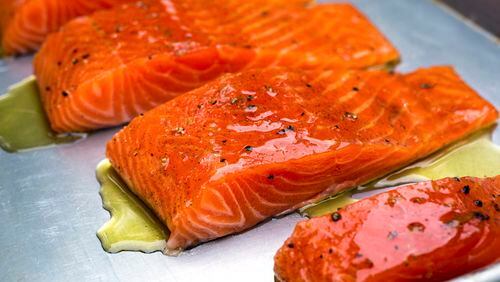Alzheimer's disease is the most common form of dementia and the sixth-leading cause of death in the U.S., according to a recent article in Cooking Light magazine. Most of us have had a loved one touched by the progressive, irreversible disorder where the brain's nerve cells degenerate, causing memory problems and behavior changes.
Sadly, researchers have not yet identified a cause or an effective long-term treatment. What is known is that the brains of Alzheimer's patients contain abnormal deposits of proteins, called amyloid plaques. The plaques build up around the brain's nerve cells, which lead to blocked communication between brain cells.
Researchers say two factors may play a role -- damage by free radicals and inflammation.
What can be done to prevent mental decline and boost brain health?
Researchers at Rush University Medical Center developed a diet that helped lower the risk of Alzheimer's by as much as 53 percent in study participants who followed it rigorously, and by as much as 35 percent in moderate followers. Called the MIND diet, it's a blend of the Mediterranean and DASH diets.
The MIND diet includes seven foods that help feed a healthy brain.
--Fish such as tuna and salmon, which are high in omega-3 DHA fatty acid, which reduces oxidative stress and slows plaque buildup.
--Blueberries, at least 2 cups a week, which are packed with antioxidants.
--Nuts, such as walnuts, which are high in omega-3s, vitamin E and antioxidants. Suggested intake is 1 ounce a day.
--Beans are natural brain boosters because of their B vitamins and phytochemicals and glucose, which feed the brain. Suggested intake is 4 or more meals a week.
--Dark leafy green, which are packed with folate and phytochemicals, both linked to a lower risk of mental decline. Suggested intake is at least 6 cups a week.
--Extra-virgin olive oil: research has found that olive oil improved learning and memory by reversing oxidative damage in the brains of mice.
--Wine: some studies link moderate alcohol intake with improved memory and possibly even lower Alzheimer's risk. Suggested intake is nor more than 1 glass a day.
In contrast, a study published in the July issue of the Journal of the American College of Nutrition, found that a western diet may increase the risk of Alzheimer's. The Western diet is characterized by the consumption of meat, sweets and high-fat dairy products.
Q and A
Q: What are "green" chickpeas?
A: Mature chickpeas, also known as garbanzo beans, are legumes most commonly found in canned or dried form. They are the main ingredients in the Middle Eastern dip called hummus. Mature chickpeas are beige or blond. Green - essentially fresh, young - chickpeas are relatively new in the U.S. They are harvested earlier, before they are dried, and offer a creamy, almost buttery, texture compared to the mature chickpeas, which are starchier and mealier. Green chickpeas are described as having a flavor similar to spring peas. They can be found in the freezer section of the supermarket or sometime fresh at a farmer's market. Chickpeas, both mature and green, are a good source of protein, fiber, vitamins and minerals, and have a low glycemic index. The immature peas can be eaten raw, straight form the pod, as a snack, or in a salad. They can be blanched and used in any recipe that calls for beans. Because they are a source of protein, green chickpeas can be added to other green foods like guacamole, making the resulting dish a better source of protein without altering the color or texture of the original. - Environmental Nutrition, December 2016.
RECIPE
Here's a recipe to take advantage of salmon's heart healthy/brain health benefits It's from Cooking Light magazine.
Sesame Salmon with Green Onions and Lemon
4 (6-ounce) sustainable salmon fillets (such as wild Alaskan)
Cooking spray
2 tablespoons sesame seeds
2 tablespoons black sesame seeds
1/2 teaspoon salt, divided
1 tablespoon butter
1 tablespoon extra-virgin olive oil
2 cups (1-inch) slices green onions
5 thin lemon slices, halved
1/4 teaspoon black pepper
1 cup baby arugula
Preheat oven to 400 degrees. Arrange salmon in a single layer on a jelly-roll pan coated with cooking spray. Combine sesame seeds and 3/8 teaspoon salt; sprinkle evenly over flesh sides of fillets, pressing gently into fish. Bake at 400 degrees for 14 minutes or until desired degree of doneness. Melt butter in a medium saucepan over medium heat. Add oil to pan; swirl. Add green onions; cook 2 minutes, stirring occasionally. Add lemon slices; cook 2 minutes. Sprinkle green onion mixture with remaining 1/8 teaspoon salt and pepper. Place 1 fillet on each of 4 plates. Place arugula in a medium bowl. Add green onion mixture to bowl with arugula; toss. Divide arugula mixture evenly among servings. Serves 4.
About the Author






